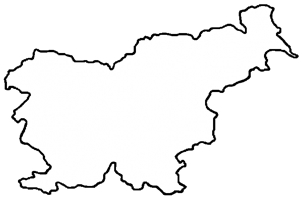
|
The Society of Folk Dance Historians (SFDH)
Slovenia:
[
Home |
About |
Encyclopedia | CLICK AN IMAGE TO ENLARGE |

|
 When the ill-advised state of Yugoslavia was created following World War I, one of the major mistakes was the inclusion of the tiny country of Slovenia.
When the ill-advised state of Yugoslavia was created following World War I, one of the major mistakes was the inclusion of the tiny country of Slovenia.
Of all the mutually distrustful ethnic groups included, Slovenia was perhaps the very worst fit; its only commonality was the Slavic nationality of its people. Everything else was glaringly different. Those who recall the break-up of Yugoslavia will remember that the Slovenes were the earliest and most militant, and successful, of the Yugoslav member states to withdraw and claim its own sovereignty.
Tucked into a tiny wedge of land between Austria and Croatia and reaching from the Adriatic Sea to the very western border with Hungary, this tiny jewel of a place is truly unique, not only in its ethnicity, but its culture, folklore, and traditions. It is one of those areas most fascinating to ethnologists where multiple cultures overlap and combine to create a unique cultural blend quite unlike any of its contributors. Theirs is a rich and contented folkore of which the Slovenes are proud and which is very much alive.
Located at the westernmost reach of Slavic migration in Europe, Slovenia lies at the eastern end of the Julian Alps and the Dinaric Mountains, the western end of Pannonia Plain and the northern end of the Adriatic Sea. Stunningly beautiful mountain scenery in the north, heavily forested slopes and fertile plains to the south and east, result in a very mosaic structure with extremely diverse regions and macroclimates remarkable for so small a country. It is no surprise that tourism is a major industry.
Never exposed to the vagaries of the Ottoman Empire, Slovenia was an integral part of the old Hapsburg Austro-Hungarian Empire. Their language is Slavic; Slovene is the official language and they readily understand their Croatian neighbors to the south (indeed, most Slovenians speak multiple languages, including Italian, Austrian, and Hungarian), but their music and celebratory traditions are Austrian. To one familiar with German and Austrian dance and music, it takes a moment to realize that the words to the traditional songs are unintelligible; the melodies may be Austrian, the instruments are Austrian, the music is in major key, but the words are Slavic. One encounters the same phenomenon in the Czech Republic, another Slavic people who were part of Austria-Hungary and strongly influenced by Teutonic traditions.
If the music is Austrian in character, the folk dress is an interesting blend of Austrian, Bunjevci (Vojvodina), and Hungarian, with some regional variations along the Croatian border resembling their neighbor's traditional loose-fitting white garments.
The best known, and considered the "national folk dress," of the men consists of a jaunty black fedora like the Hungarian men wear, a tight fitting brocade vest like the Bunjevci wear, black knee-length white pantaloon like the Croatians wear, and fine black Hungarian-style boots. Under the vest, a fringed shawl is worn over a full-sleeved white shirt with the corneres of the shawl showing at the shoulder of the vest.
Women wear the familiar dirndl-style folk dress found all over Europe, usually dark, with a colorful triangular fringed shawl worn over the shoulders with the ends tucked into the waistband in the front. The charming cap is a white fabric pleated into an embroidered band worn across the forehead. There are many regional variations, of course, but this attractive ensemble is found everywhere in Slovenia.
 Slovenian folk dance is almost exclusively couple dance and appears to come in two forms: the Polka and "play" dances. The Polka is the traditional polka of the Tyrol, danced gently in contrast to the more aggressive Polka of Bavaria. Folk dancers have learned many dances over the years in which couples alternate shaking fingers at each other, a motif that appears throughout northern Europe. Turning couple dances feature the Waltz, Polka, a turning two-step, and pivots.
Slovenian folk dance is almost exclusively couple dance and appears to come in two forms: the Polka and "play" dances. The Polka is the traditional polka of the Tyrol, danced gently in contrast to the more aggressive Polka of Bavaria. Folk dancers have learned many dances over the years in which couples alternate shaking fingers at each other, a motif that appears throughout northern Europe. Turning couple dances feature the Waltz, Polka, a turning two-step, and pivots.
Perhaps the most characteristic feature of the dance is its gentle playfulness and easy relationship between partners. No domination of one by the other, no boastful displays of prowess or coy display of feminine charms. There is a charming innocence that tells of contentment with their world and who they are.
And well they should be. Slovenia is one of Europe's loveliest jewels. None, not even Bavaria or Switzerland, can claim more beautiful Alpine scenery, more picturesque mountain villages, or a more inviting world for tourists. Slovenians love their outdoor sports, especially the Alpine events, and their long continued success in international competition is remarkable for so small a country. Slovenians love dance and music and it is one of the few countries where folk dance is readily found, and not just as a performance, but as part of many social gatherings.
In America, Slovenians have happily maintained their identity and traditions. Slovenian Hall in Fontana, California, has for years maintained a buttonbox (accordion) club and it is a unique experience to sit in the midst of a group of somber-faced buttonbox players contentedly squeezing out lovely Slovenian fok melodies. There also is an active Slovenian dance band popular with the polka dance community. The recreational folk dance repertoire includes a few traditional Slovenian dances – but not nearly enough.
DOCUMENTS
- Balkans, a region.
- Richard Duree, an article.
- Slovenia, a country.
- Yugoslavia, a former country.
Used with permission of the author.
Printed in Folk Dance Scene, August 2013.
This page © 2018 by Ron Houston.
Please do not copy any part of this page without including this copyright notice.
Please do not copy small portions out of context.
Please do not copy large portions without permission from Ron Houston.